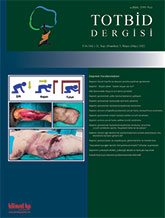
The second leading cause of death in earthquakes is crush syndrome resulting from muscle trauma. The importance of crush syndrome is rhabdomyolysis, which develops as a result of the release of intracellular components into the systemic circulation in striated muscle cells as a result of compression of the muscles. As a result of the rapid transition of extracellular water into the muscle cell, the muscle cell swells and the intramuscular pressure increases, resulting in compartment syndrome. Acute kidney injury occurs as a result of impaired renal perfusion due to hypovolemia caused by compartment syndrome. It is typical for urine to appear dark brown due to elevated serum creatinine kinase and myoglobinuria developing due to muscle damage. The resulting hyperkalemia is important because it is life-threatening. The most important factor in treatment is to replace the fluid deficit. Isotonic sodium chloride is frequently used after an earthquake due to its easy availability. The amount to be given should be individualized according to the person. Intermittent hemodialysis is the preferred method when dialysis is required. As a result; since the effects of crush syndrome can be avoided with appropriate and aggressive fluid therapy, these patients should never be left untreated, and it should not be forgotten that the treatment should be started under the rubble.